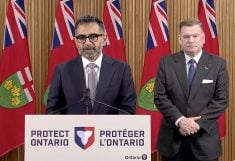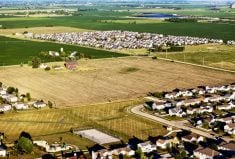It’s safe to say that most farmers in Canada don’t really know the history of farm policy developments in this country and they don’t really care.
What they do care about is whether supports will be there for them in their times of need, whether that’s when dealing with this year’s drought, last year’s pandemic or any other disaster that surfaces.
However, understanding the backdrop to the newly launched negotiations and consultations over the next national Agricultural Policy Framework (APF) could be critical to the effectiveness of the policies that emerge.
Read Also

Defence investments could benefit agriculture
A bump in Canada’s NATO spending commitments could lead to infrastructure investments that would benefit rural areas
It could also prove useful for industry and public stakeholders to understand where and how they should exert pressure in the process to ensure their concerns are heard and their interests are met.
The Canadian Agricultural Policy Institute (CAPI) turned to agricultural economist Douglas Hedley to analyze where farm policy has come from in this country and where it might need to go. Hedley’s long career with Agriculture and Agri-Food Canada included serving as assistant deputy minister for Farm Financial Programs in the early 2000s.
The existing suite of programs designed to help farmers with business risk management, support industry innovation, and recover from disasters is due to expire in 2023.
Hedley points to the shared federal-provincial jurisdiction over agriculture as one complexity in the equation. Getting everyone to agree, especially on issues such as climate change, is difficult. At the same time, governments at all levels are having to deal with near-term crises in rapid succession.
“The emerging economic and political stage is both unpredictable and unstable,” Hedley writes. “Rather than designing policies for the longer term as in climate change and research, policy processes need to be fostered and maintained to enable Canada to respond quickly in an ever-changing domestic and international environment.
“Policy approaches need to be nimble, able to respond rapidly to events domestically and internationally, and founded on an improved and strengthened relationship with provinces and territories.”
Hedley points to the origins of the first agricultural policy framework in the early 1990s as pivotal to the relative stability of farm policy development in the following decades. Then federal minister Don Mazankowski was able to convince provincial and territorial colleagues to move towards a whole-country, whole-farm approach.
Regional programs such as the freight subsidies for both west and east, or sector-specific supports such as tripartite stabilization led to counter measures to offset the real or perceived impact on other regions or sectors. They also became easy targets for claims of unfair trading practices.
The ability of the federal, provincial, and territorial (FPT) governments to co-operate during that era was a major factor enabling policies to look beyond funding direct farm supports to boosting research and market development.
The other reality that farmers must face this time round is that they are no longer the only stakeholders wanting to be heard. Consumers, non-farming rural residents, and single-issue advocacy groups are now demanding a seat at the table too.
Even within government, agriculture shares touchpoints with multiple portfolios, including environment, health, rural, trade, labour, and science.
Plus, Canada’s global competitors are demonstrating waning interest in disciplined trade, which puts smaller countries like Canada at a disadvantage.
It raises the question of whether the current approach can deliver.
Hedley says FPT governments need to first focus on quickly responding to the rapidly changing needs of the industry.
“This effort can only be developed with a strong sense of commitment and trust among FPT partners, across the horizontal and vertical organization in the sector, and the wider interests of organizations and interests of society regarding agriculture and food,” Hedley says.
The second is a long-term effort to bring stability back into domestic and international trade.
“Both suggestions are more focused on the processes for the development of policy actions than on policy solutions,” Hedley notes.
Where does all this leave farmers, whose numbers continue to shrink and whose voices are often fractured even within the sector? They need to align with like-minded interests, whether it is around environment, trade, or food security in order to make their case.
They will need to be able to explain how what’s good for them is good for everyone in ways beyond their impact on the economy.
Developing a new policy framework has never been more complicated. Likewise, it has never been more necessary.
Laura Rance is vice president of content for Glacier FarmMedia. She can be reached at [email protected]















